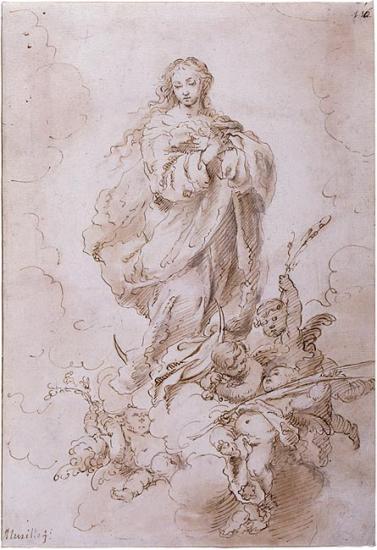Bartolomé Esteban Murillo

The Immaculate Conception
Signed (?) at lower left, in brown ink, Murillo ft.; numbered at upper right, 116
Gift of J. P. Morgan, Jr., 1924
Murillo made this preparatory sketch for one of his many versions of the Immaculate Conception. The free, sketchy handling of this drawing is typical of the artist’s late style and the work is close to one of his paintings, now in the Cleveland Museum of Art, as well as a small picture in a private Spanish collection. The doctrine of the Immaculate Conception was especially popular in seventeenth-century Spain. Here, this abstract ideal is embodied in the figure of the Virgin standing on a crescent moon.
From the sixteenth to nineteenth centuries, Spain witnessed the rise of the Catholic Church along with the flourishing of court artists who explored deeply spiritual visions. Concurrently, the nightmare of the Inquisition drove artists to probe the darker side of human nature through scenes of martyrdom and torture. Drawing played a central role in their conception of these diverse subjects—from Murillo's preparatory studies for painting commissions to Goya's private albums satirizing contemporary society. In addition to this rich tradition in Spain, Spanish artists also worked abroad, notably in Naples, which was a Spanish territory.
Visions and Nightmares marks the first exhibition of Spanish drawings at the Morgan, whose holdings in this area are small but significant. Showcasing over twenty sheets by Spanish artists spanning four centuries, this selection traces the shifting roles and attitudes toward the art of drawing in Spain.
This online exhibition was created in conjunction with the exhibition Visions and Nightmares: Four Centuries of Spanish Drawings, on view January 17 through May 11, 2014 and organized by Edward Payne, Moore Curatorial Fellow.
This exhibition is made possible by the A. Woodner Fund.